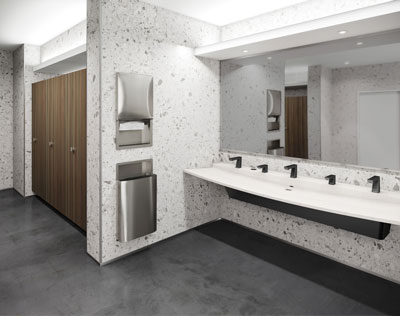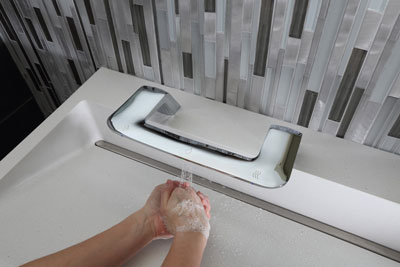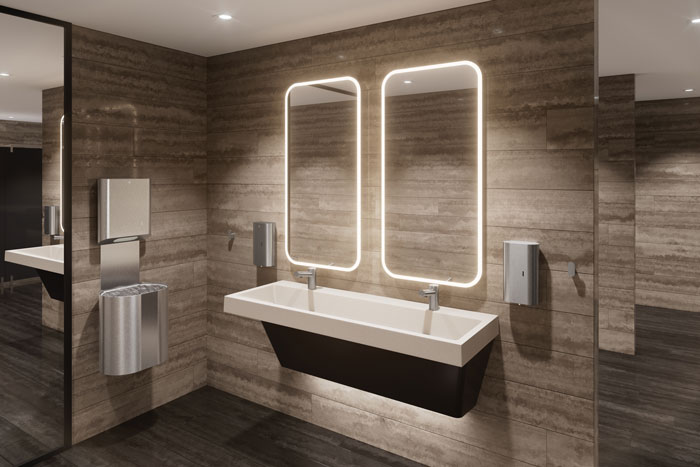The condition of a business’ restrooms really does matter—to patrons as well as the businesses that provide them.
Think of the times when you encountered a poorly maintained restroom that is messy, dirty, unstocked or nonworking. If you felt a swell of irritation and disappointment, you’re not unlike most people. Unkempt restrooms can make restroom users feel let down and neglected. They also cause restroom users to hold the business or establishment accountable—whether or not they are responsible for making the mess. For recreational facilities, negative restroom appearances have the power to damage business reputations.

An annual survey of Americans’ perceptions and beliefs regarding restrooms shows that whether people use a public restroom at a commercial facility, business or their workplace, they have high expectations for cleanliness. In 2024, 80% still report being more conscious about coming into contact with germs due to COVID. People now associate a hygienic restroom experience with health, safety and well-being.
Unfortunately, two-thirds (68%) of respondents reported having an unpleasant experience in a restroom due to the condition, according to the 2024 Healthy Handwashing Survey, conducted by Bradley. Further, the majority believe a poorly maintained restroom shows poor management (58%), causes them to lower their opinion of the company (56%) and vow not to return or think twice about doing so (50%).
When asked the most important improvement they’d like to see in restrooms, respondents overwhelmingly said, “clean them more regularly and keep them better stocked.” Next on the wish list is making everything touchless, followed by always providing paper towels—even if there are dryers. (70% of Americans use them as a handheld shield to avoid skin contact with flushers, faucets and doors.)
On the flipside, Americans value and prioritize the cleanliness of restroom environments—so much so they will even put their money behind it. Some 60% of Americans said they would willingly spend more money at a business with clean, well-maintained restrooms. Another 60% say when out running errands they take restroom breaks at a business they know has “good” restrooms.
Restroom Pet Peeves

While there are a variety of restroom maintenance issues that turn off patrons, the most common include clogged or unflushed toilets; an overall appearance that is old, dirty or unkempt; unpleasant smells; and empty or jammed dispensers for soap, toilet paper and hand towels.
Sometimes it’s the lax or poor behavior of other restroom users that irks restroom users—which, unfortunately, still reflects poorly on the business. Top restroom pet peeves include paper towels left on the floor or sink, water splashed around the floor or sink, and careless or reckless behavior that results in damage.
Beyond maintenance, lack of restroom privacy has also emerged as a user pain point. A full 70% say that toilet stalls don’t provide sufficient privacy. The majority of Americans believe that eliminating gaps around stall doors or where the stall walls meet would help improve the sense of privacy, and 96% believe occupancy indicators on stall doors would be helpful.
While cleanliness expectations and performance specs for washrooms remain elevated, the hygiene and performance of today’s products and materials have followed suit. Here are key trends in commercial restroom maintenance and design to consider for recreational facilities:
- Touchless restroom fixtures: The days of handled and levered faucets in restrooms are numbered, and touch-free technology is the new gold standard. 86% of adults believe it is important to have touchless fixtures in a public restroom, and 70% say they are more likely to return to a business that offers no-touch capabilities in its restrooms. The touchless restroom features considered most important are faucets, flushers, soap dispensers and paper towel dispensers. From an operational efficiency standpoint, touchless fixtures are easier to keep clean, maintain and service than manually activated fixtures. While automated technologies may require some modifications to the existing plumbing and electrical systems, they are often relatively straightforward for retrofitting into a current restroom space.
- All-in-one handwashing designs: One type of touchless handwashing technology is a completely touch-free “all-in-one” design. By combining soap, faucet and hand dryer into the handwashing system, hygiene, maintenance, accessibility and sustainability are improved. This handwashing concept also improves water containment inside the washbasin, as the hand dryer is engineered to work with the basin to keep water in the bowl. This prevents water from dripping from hands onto the user, walls and floors, helping to eliminate slips, trips and falls and extra floor mopping.
- Top fill multi-feed soap systems: With all-in-one handwashing models, an efficient top-fill multi-feed soap system can significantly cut down on soap refills. This system incorporates a large-capacity tank that can supply up to three units, allowing staff to efficiently refill multiple soaps through a single top-fill hub. A smart system with LED indicator shows when soap/battery levels are low and provides audible and visual indicators to prevent overfilling.
- Phenolic lockers: Water- and moisture-resistant, phenolic locker models are perfect for providing a clean and modern look in moisture-prone aquatic and recreation centers. This resistance helps prevent the growth of mold and mildew, ensuring a hygienic and low-maintenance solution in locker rooms. Having a smooth, nonporous finish, they are easy to clean, durable and long-lasting for high-traffic locations. When specified with phenolic restroom partitions in matching or coordinating colors, it’s easy to create a cohesive and consistent look between the locker room and the rest of the washroom.
For today’s recreational facilities, maintenance and cleanliness are clearly driving restroom and locker room design. Fortunately, there are a number of strategies and product models that will help these public spaces reflect positively on all who use them. RM
ABOUT THE AUTHOR
Jon Dommisse is vice president of business development and strategy for Bradley Company, the 100-year-old global manufacturer of commercial plumbing fixtures, washroom accessories, emergency safety fixtures and electric tankless water heaters, now a division of Watts Water Technologies.



